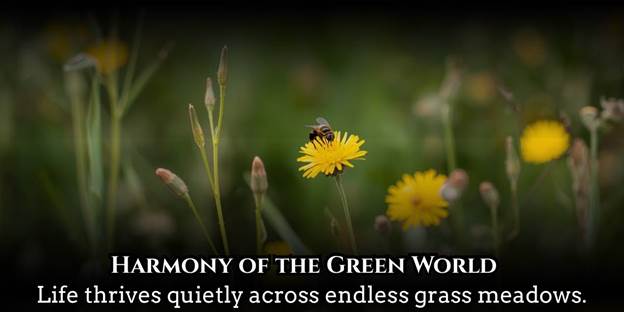Grass meadows are among the most vibrant yet overlooked ecosystems on Earth, providing essential support to biodiversity, soil health, and climate regulation. Stretching across plains, valleys, and mountain slopes, these lush landscapes are home to countless species of plants, insects, and animals that coexist in delicate balance. Despite their quiet beauty, grass meadows face increasing threats from urban expansion, overgrazing, and climate change.
Table of Contents
This article explores how grass meadows contribute to global biodiversity, their ecological significance, the challenges they face, and the steps we can take to preserve these living treasures. From their historical role in supporting ancient civilizations to their modern-day importance in sustaining ecosystems, grass meadows remain vital to the health of our planet.

The Living Definition: What Are Grass Meadows?
Grass meadows are open landscapes dominated by grasses, wildflowers, and small shrubs. Unlike forests, they have minimal tree cover, allowing sunlight to nurture ground-level vegetation. These habitats can occur naturally or be shaped by human activity such as agriculture and grazing. Ecologists often describe grass meadows as transition zones between forests and deserts, creating diverse environments that support numerous life forms.
Grass meadows appear in various climates from the North American prairies to European meadows and African savannas each hosting unique flora and fauna. The balance of these ecosystems depends heavily on soil quality, rainfall, and temperature, all of which influence plant growth and animal survival.
A Historical Glimpse: The Evolution of Meadow Ecosystems
Grass meadows have existed for millions of years, evolving alongside grazing animals like bison and antelope. In ancient times, human civilizations depended on meadows for food, medicine, and livestock. Early agricultural societies recognized their value, using these fertile lands for seasonal grazing and crop cultivation. Over centuries, meadows became intertwined with rural cultures, folklore, and traditional farming systems.
However, modernization and industrial agriculture have drastically reduced natural meadows. Many of these landscapes were converted into urban areas or monoculture farmlands, leading to habitat loss and species decline. Understanding their historical roots helps us appreciate why protecting grass meadows today is vital for maintaining ecological balance.
Biodiversity in Grass Meadows: Nature’s Hidden Symphony
Grass meadows may look simple, but beneath their soft green layers lies a bustling network of life. These habitats host:
•Thousands of plant species, including rare orchids and wildflowers
•Pollinators like bees, butterflies, and beetles crucial for reproduction
•Birds, small mammals, and reptiles relying on meadow vegetation for shelter
•Microorganisms that enhance soil fertility and carbon storage
Biodiversity in meadows ensures resilience against environmental changes. When one species declines, others adapt, keeping the ecosystem stable. This intricate web of interactions also supports food chains vital to humans demonstrating that protecting grass meadows is directly linked to global food security.
Ecological Importance: Why Grass Meadows Matter
Grass meadows play a critical role in sustaining life on Earth. Their importance extends beyond beauty and biodiversity:
•Carbon Sequestration: Meadow grasses absorb and store large amounts of carbon dioxide, helping reduce global warming.
•Soil Health: Root systems prevent erosion and enhance soil structure.
•Water Regulation: Meadows act as natural sponges, absorbing rainwater and reducing flood risks.
•Pollination and Food Production: Many crops rely on pollinators that breed in grasslands.
By maintaining these natural systems, grass meadows act as green guardians of our planet’s health. Losing them would mean losing essential ecosystem services that sustain life.
Threats and Challenges: The Silent Decline
Despite their importance, grass meadows are disappearing at an alarming rate. The main challenges include:
- Urbanization Expanding cities replace meadows with concrete and infrastructure.
- Overgrazing Excessive livestock grazing damages plant diversity and soil stability.
- Climate Change Altered rainfall and temperature patterns disrupt natural growth cycles.
- Agricultural Intensification The use of chemicals and heavy machinery degrades meadow ecosystems.
These factors contribute to habitat fragmentation and species extinction. According to global studies, nearly half of natural grass meadows have vanished in the last century. Without conservation measures, this trend will continue to accelerate.
Conservation Efforts and Sustainable Solutions
Restoring and protecting grass meadows requires collaborative efforts from governments, communities, and individuals. Effective strategies include:
•Reintroducing native plant species to degraded lands
•Establishing protected meadow reserves and biodiversity corridors
•Encouraging sustainable grazing and organic farming
•Promoting awareness programs and eco-tourism
•Supporting pollinator habitats and natural seed regeneration
In several countries, restoration projects have successfully revived meadow ecosystems. For example, in the UK, “Wildflower Meadow Revival” initiatives have brought back native grasses and pollinators. Similarly, the U.S. “Prairie Restoration Movement” focuses on reconstructing natural habitats to improve biodiversity and soil health.
The Future of Grass Meadows: A Shared Responsibility
Protecting grass meadows is not just a scientific task but a moral duty. As climate change accelerates, these landscapes become even more essential in maintaining ecological balance. By supporting conservation programs and reducing environmental footprints, individuals can make a difference. Every small action from planting native flowers to supporting sustainable products contributes to preserving the meadows’ silent harmony.

Conclusion
Grass meadows are far more than green fields they are the heartbeat of biodiversity and a lifeline for ecosystems. Their ability to nurture life, regulate climate, and sustain humanity makes them irreplaceable. Protecting grass meadows ensures a thriving planet for future generations. As guardians of nature’s quiet beauty, we must act now learn more, spread awareness, and support global efforts to restore these vital landscapes before their silence becomes permanent.